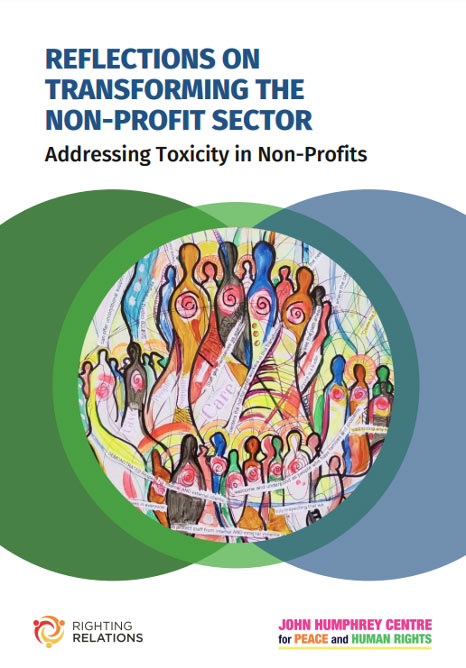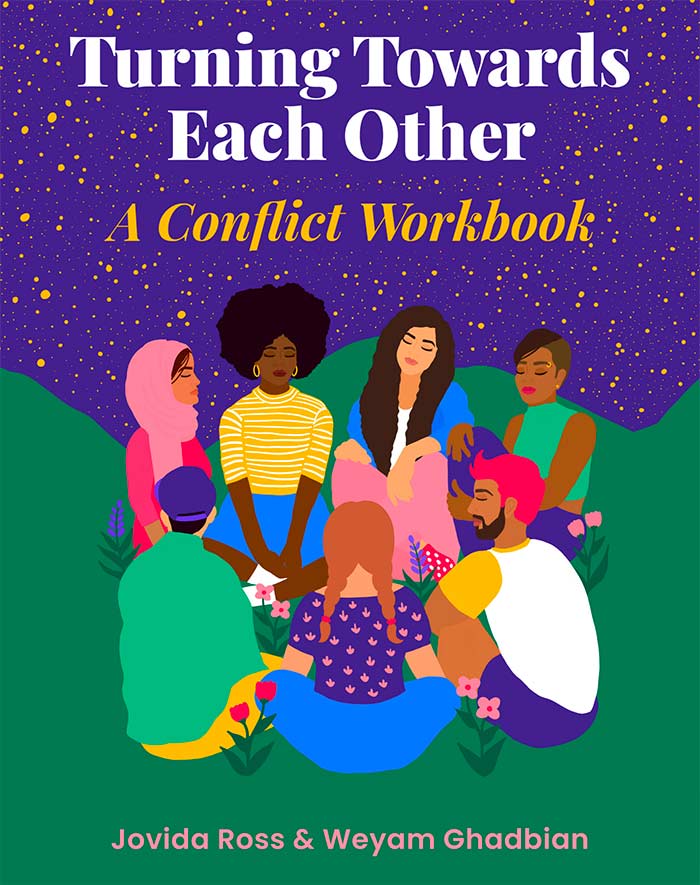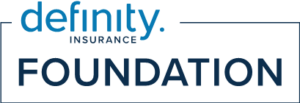Decent processes for resolving conflicts
An environment where people can express their concerns, participate equally, and feel included and safe in the workplace, underpins all aspects of decent work. This includes strong employment standards, establishing codes of conduct, developing proactive policies for equity, anti-racism, and reconciliation, ensuring the safety of workers, respecting the mental and physical health of employees, and ensuring that employees understand they have the right to organize, and speak up about workplace concerns.
It’s important to note that conflict is a normal aspect of working relationships, rather than trying to avoid it, organizations should lean into decent work practices that allow for conflict to be addressed in healthy ways. Suprabha Sharma describes five benefits of healthy conflict in the workplace.
She mentions that healthy conflict:
Increases security and trust
Helps in understanding different perspectives
Leads to better decision making
Helps identify surface issues
Builds commitment.
There is no doubt that conflict can have an impact on employees wellbeing if not addressed adequately, and can further create toxic work environments. Creating processes, and engaging in conversations about conflict is a critical way to advance decent work.


| Does our organization have clear, accessible and confidential grievance procedures, policies, and practices in place to support staff in addressing, and resolving conflicts with co-workers and supervisors? | |
|---|---|
| If not unionized: policies are in place, but are not often used or followed in practice. | |
| If not unionized: policies are in place, and are regularly used to identify and address conflicts. | |
| If not unionized: policies are in place, are regularly used, and staff have access to support or third party assistance as part of such processes. | |
| Under our union collective agreement. | |
| Policies and collective agreements are reviewed regularly. | |
| Does our organization have policies to ensure the safety of workers? (for example, case workers are paired when going to visit high-risk clients) | |
| There is a policy but it is rarely followed. | |
| There is a policy, sometimes followed. | |
| There is a policy and it is always followed. | |
| When conflict arises in the workplace, how is confidentiality maintained? What are the safeguards against reprisal and/or backlash? | |
| There is a policy but it is rarely followed. | |
| There is a policy, sometimes followed. | |
| There is a policy and it is always followed. | |
| Does our organization use an equity/anti-racist lens to conflict resolution? Do we consider how power and privilege may be playing into dynamics of conflict? | |
| No, we don’t have any practices that acknowledge equity when conflict occurs in the workplace? | |
| Yes there is a policy, but it’s only used when formal complaints are made. | |
| Yes, there is a policy and practices in place to examine power differentials and equity when conflict arises in the workplace. Within our organization, we are actively discussing and re-assessing ways to enhance our practices/policies. |
Resource: Turning towards each other- Conflict workbook
So what do we do when we inevitably run into conflict? This was the question on our minds when we wrote a new conflict workbook for groups working towards a shared purpose. As two people who come from community-building and social movement backgrounds, we have seen and experienced dreams crumble because we, or people we love, couldn’t find a way through a difficult interpersonal conflict with a comrade or a colleague. We care deeply about our communities and the ways they’ve been harmed by structural oppression. We put together Turning Towards Each Other because of all the times we found ourselves in gut-wrenching, sometimes relationship-ending tangles with people we depended on ”
Weyam Ghadian and Jovida Ross
Decent work and anti-racist conflict resolution practices
|
When conflict arises within the workplace, it is normal for emotions to surface. In promoting equity, and the advancement of decent work, it’s important to recognize how to address conflict using an equity lens. One way you can do that is by having active conversations about tone policing. Why is it important to address tone policing?Tone policing propagates the idea that conversations and debates must be delivered in a calm voice and demeanour in order to be productive—and it’s usually targeted at women, and other historically underserved groups. Lung says, “The most common way I see [tone policing] manifesting is [through] the feedback culture that’s created by verbalizing that ‘if only’ the message was conveyed in a different way, then it would be heard.” Experiencing racism, sexism, or other forms of oppression has an impact on how folks raise issues of conflict within the workplace. Conflict may arise from experiences of oppression such as sexism, racism, homophobia in the workplace. When employees are disclosing it’s important to be open, and mindful that they may not communicate in “professional” ways. Employees should not be penalized for how they communicate harm. In the article, How Tone-policing is Harming Your Employees of Color by Janice Gassam Asare, Ph.D., she highlights three ways to address tone policing in the workplace. She names that organizations should first become aware of tone policing, and do intentional learning on the topic. Secondly, she suggests that employees’ emotions shouldn’t be invalidated – when bringing up experiences of racism and harm, it’s normal to feel anger, sadness and/or rage. Lastly, it’s important to create brave spaces of listening, to support emotional processing, and if possible refer employees to employment assistant programs that offer support around racism and equity in the workplace. Addressing tone policing advances decent work and equity because it addresses the ways in which employees experience psychological unsafety. |
|
Take all of the disciplinary actions that have occurred over a time period, and disaggregate the data. Examine the measures being taken, and for what reason for white employees, all racialized employees, Black employees, and Indigenous employees. Do you notice that the consequences for the same action have different outcomes? Consider how your organization can move away from models of punishment, and implement restorative practices that centre the development or growth of employees instead. Here are some considerations on how to create pathways of accountability: Think people first and focus on the conversation, not the disciplinary form or documentation. When employees find themselves in a space of disciplinary action, this may cause undue stress. When giving feedback to the employee, consider what follow-ups may be needed. Change the name of the disciplinary steps. Reprimands and warnings may carry negative baggage that can get in the way of problem-solving, and commitment. Consider changing what you call disciplinary action to something that focuses on accountability rather than shaming the employee such as “notice” or “conversation”. Give people a way to clear their record. Sooner or later employees need to know that they have earned the right not to have a past mistake held against them for their entire employment. |
|
The need for intentional conflict practices require an examination of how privilege, power, and issues of inequity show up within nonprofits. Nonprofits that seek to create cultures of conflict transformation must be resilient towards addressing inequities that arise. In the BIPOC Checklist created by Toronto Neighbourhood Centres, they encourage the following practices to advance a decent conflict process: Create affinity groups/spaces that advance networking opportunities, thought leadership on anti-oppression work, and community of care. Create a mechanism to confront bias and exclusion within the agency, and ensure that protections are in place for Black, Indigenous and/or racialized staff bringing information forward. Integrate ongoing conversations where staff can reflect, and share how power is showing up in the workplace. Create a mechanism to address experiences of microaggressions/ oppression within the organization; all staff, but particularly leadership should be aware of their responsibilities, and the organizational expectations with regards to addressing inequity, and inappropriate actions/comments. Consider using a multiracial panel to review “disciplinary decisions on a regular basis”. If such a panel does not exist (or would put undue burden on a limited number of BIPOC employees) consider including volunteers, clients, or other community members, and compensating them for their time. In May 2023, Righting Relations released a toolkit to address toxicity within nonprofits. The project started in March 2020, at the John Humphrey Centre for Peace and Human Rights’ (JHC) human rights facilitator training. During the training, members of the Righting Relations National Network of Adult Educators for Social Change shared some of their difficult experiences working within nonprofit organizations. This conversation led to the creation of the Righting Relations Non-Profit Organizations (NPO) Transformation Working Group [now, Righting Relations Non-Profit Sector (NPS) Change Lab]. This group of Righting Relations (RR) members has years of experience working in the nonprofit sector, and is inspired by the urgent need to explore the challenges of the sector, and strengthen spaces of healing, resistance and transformation within the work we do. Members of this working group are driven to identify strategies that encourage nonprofits to adopt decolonizing, heart-centered practices that meet the needs of people, and workers. The toolkit serves as a “labor of love” in examining tools to support culture change within nonprofits using an equity lens.” – Ally Crockford, Righting Relations Coordinator  |
Know your Rights At Work
The Workers’ Action Centre (WAC) is a worker-based organization.that is committed to improving the lives and working conditions of people in low-wage and unstable employment. WAC developed the Know your Rights at Work booklet that provides a summary of your rights at work under the various laws that protect workers in Ontario and Canada.They are champions for decent work in Ontario’s nonprofit sector and beyond.




